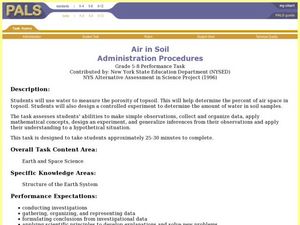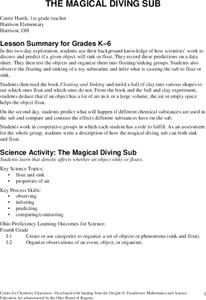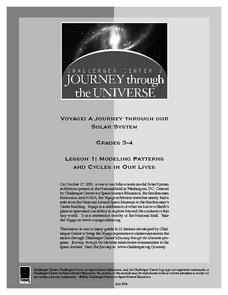Curated OER
Air: You Cant See It, But Its There!
First graders state that air occupies space by performing experiments that show this principle.
Curated OER
Science: Breathing in Space
Pupils determine the amount of air they use during rest and activity. They conduct experiments to calculate the number of breaths needed to empty a jug of water by exhaling through a tube into the container. Then, they figure how much...
Curated OER
Chemistry: The Collapsing Can
Students observe methods by which air can crush aluminum cans. As water in the can boils and is sealed, the can collapses as it cools. When the procedure is reversed, the can expands to its original shape. After the alternate experiment,...
Curated OER
Newton's Laws 8th Grade Activities
Eighth graders experiment with Newton's Laws by comparing the falling of different objects with different masses. Students work in teams and rotate through four different stations recording their hypotheses and observations as they go.
Curated OER
Take a Stab!
Pupils construct an experiment to test the rigidity of compressed air and its strength. In this earth science lesson, students are divided into groups, and by putting their thumb over the end of a straw, use the compressed air strength...
Curated OER
Build Your Own Anemomter
Students investigate how to measure the speed of wind. They do this by building their own anemometers. Students calculate the air speeds while using their own projects and make observations. They conduct a mathematical discussion after...
Curated OER
Clouds, Winds, and Weather
Young scholars observe, record, and report weather conditions to learn how air mass densities determine the weather we experience daily. They demonstrate how clouds form, name clouds and predict the weather.
Curated OER
Air in Soil Administration Procedures
Students study soil and its composition. For this soil composition lesson, students study examples of soil during several days of aeration. Students summarize their data, organize it, and must be able to explain their findings.
Curated OER
The Science of Airplane Flight
Students define terms, explain Bernoulli's principle and identify the control surfaces of an airplane. In this investigative instructional activity students complete a lab activity.
Curated OER
Soaring With Air Power
Fourth graders view a Newton's Apple show that explores glider mechanics, explore the four forces, build and fly a glider to specific guidelines. They adjust the glider for greater accuracy and distance using four forces, and assess...
Curated OER
Astrophysics Science Project Integrating Research and Education
Students determine if the particles are coming from above, below, or from one side or the other by using a circular array of scintillators
Curated OER
Is the Earth Warming? a Test of the Effect of Increased Carbon Dioxide on the Thermal Properties of Air
Students investigate the environmental and economic effects of increased carbon dioxide (CO2) content in the atmosphere.
Curated OER
Apple Science
Sixth graders explore agriculture by viewing a fruits and vegetables video clip. In this apple characteristics lesson, 6th graders discuss how fruits and vegetables deteriorate after being exposed to oxygen and identify methods to defend...
Curated OER
Sounds Like Science - Bottle Organ
Pupils see that by manipulating sound we can arrange a series of notes referred to as a musical scale. They explain the relationship between pitches and notes. They compare the sounds of different-sized bottles.
Curated OER
The Magical Diving Sub
First graders discuss and predict if a given object sinks or floats. They record their predictions on a data sheet. Pupils test the objects and organize them into floating/sinking groups. Students observe the floating and sinking of a...
Curated OER
Build A Borneo Glider!
Students construct a paper glider. In this physics of gliding lesson, students first learn about Borneo and it's rainforest habitat. After students discover the way animals in Borneo glide from tree to tree, they use their newly acquired...
Curated OER
The Water Cycle (Evaporation, Condensation, Precipitation)
The 3 steps of the water cycle, evaporation, condensation, and precipitation, are the focus of this lesson plan. After a neat demonstration of rain using hot water, a pie tin, and ice cubes, young scientists observe and discuss the...
Office of the New Jersey State Climatologist
Play Ball! – Or Not…Making a Decision Using Weather Data
Should the game go on or not? An engaging lesson asks small groups to make a decision using weather data. After analyzing a map, an updated forecast, and radar information, groups have to decide whether to cancel a baseball game. They...
Cornell University
Catapults
Ready, aim, fire! Launch to a new level of understanding as scholars build and test their own catapults. Learners explore lever design and how adjusting the fulcrum changes the outcome.
Curated OER
You Have Egg On Your Face
Students explore and analyze how the human face is proportioned and explore ways artists use mathematics to make art. They demonstrate the basic face proportions by creating a reference sketch and illustrating visual clues to communicate...
Curated OER
Modeling Patterns and Cycles in Our Lives
Students explore how building a model can help them better understand the natural world. They identify common cycles or patterns in nature as well as examples of models in the classroom. After discussion, they choose a pattern or cycle...
Curated OER
Voyage: A Journey Through Our Solar System
Thoroughly written, this plan walks you through every detail of having your high school astronomers design scale models of the solar system. Complete instructions on building to scale, lesson procedures, and associated worksheets are all...
Journey Through the Universe
How Far is Far?
The earth only revolves around one thing — and it's not any of your pupils. The lesson includes two activities dealing with the distance to the sun and the moon. First, scholars create a pin hole camera and use the rules of similar...























